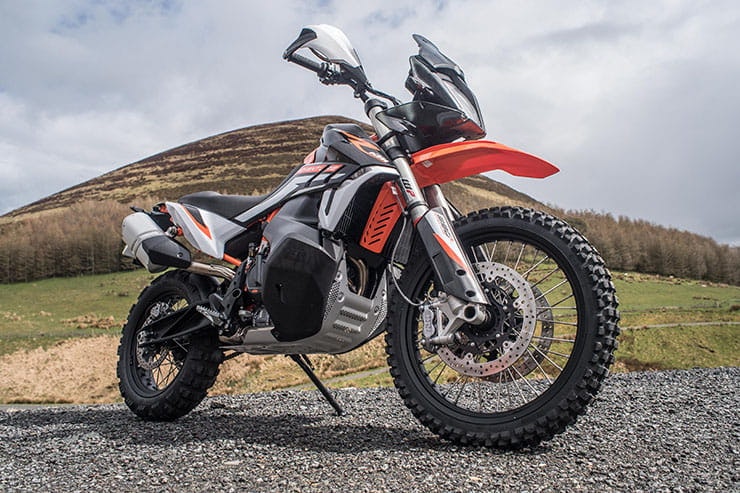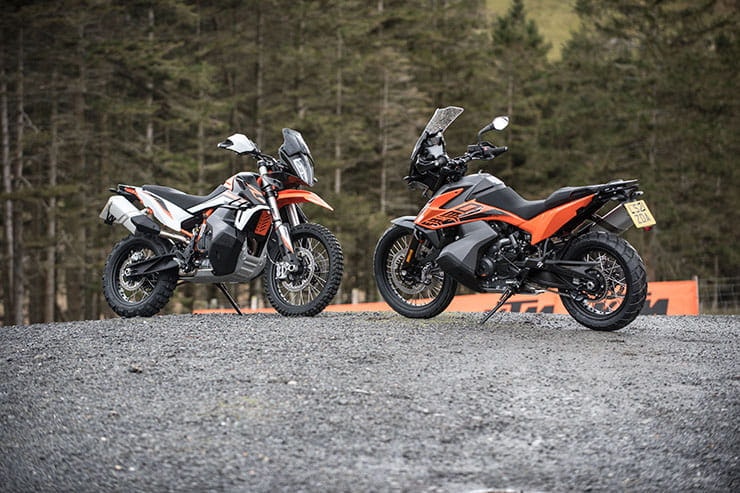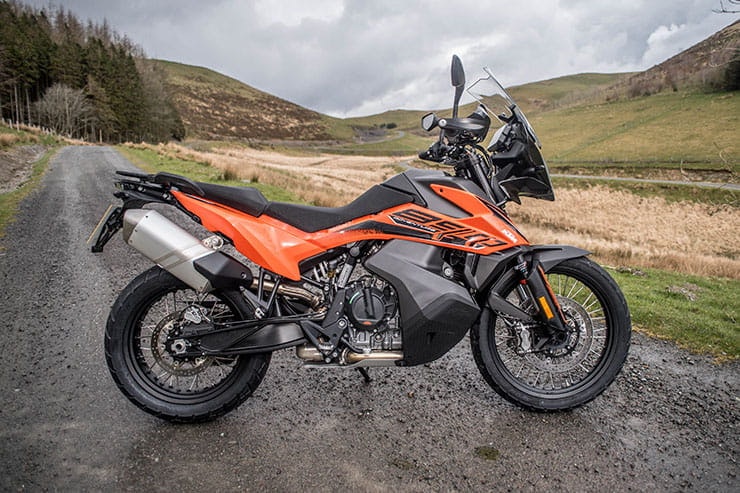KTM 890 Adventure / R (2021) - Review
BikeSocial Road Tester
29.04.2021
Only two years ago KTM launched their 790 Adventure. Funnily enough I rode the R version for the first time at Sweet Lamb in Wales, KTM’s dedicated 6600-acre off-road school. Fast forward to 2021 and I’m back again at Sweet Lamb to ride the all-new 890 Adventure and Adventure R models.
KTM had to meet Euro-5 emission standards, and increasing capacity was the simplest solution, especially as the 890 platform already existed in the KTM range. The hike in capacity means an increase in power, up 10bhp to 105bhp, and an 8.8ftlb (12Nm) increase in torque. However, the larger engine and other related changes such as a new exhaust system have increased weight too, which is now 7kg more than the previous model.
But KTM haven’t just dropped a bigger engine into the older 790 chassis. The electronics and rider aids have been updated with a new 6-axis IMU, improved cornering ABS and traction control. The quality WP suspension receives a new rear shock (non-R model), and there’s better braking to deal with 890’s extra weight.
We have two models on test: the standard 890 Adventure, and the off-road biased 890 Adventure R. The R and the standard model share the same off-road biased wheels (21in front, 18in rear), but the pricier R comes equipped with fully adjustable WP suspension with 240mm of travel, plus off-road biased rubber (Mitus on test, Metzeler Karoos as standard), a one-piece seat, a low screen, and different graphics.
Improved performance
New electronic rider aids
True off-road capabilities
Brakes feel a little wooden
Wind turbulence from screen
Quickshifter not standard
KTM 890 Adventure (and R) REVIEW
KTM's middleweight 890 Adventure jumps up in capacity from 790cc, which results in a boost in power and torque. But that’s not all, there's new improved electronics and rider aids, with a new IMU. We also take to the dirt on KTM’s 890 Adventure R.
2021 KTM 890 Adventure Price £10,999 (R - £11,999)
Usually when a new model comes out it gives the manufacturer the opportunity to add a few hundred pounds on the price and blame inflation or exchange rates, but this isn’t the case with KTM. The significantly updated 890 is actually a fraction cheaper than the old 790. It’s not often the new bike is cheaper than the old one. In fact, it’s virtually unheard of.
New bikes have edged up in price, but KTM’s middleweight adventurer, now with 105hp, is competitively priced at £10,999, or £11,999 for the R model with higher specification WP suspension.
Arguably its closest competition comes from BMW’s 850 GS Adventure and Triumph’s Tiger 900, both of which are more expensive than the KTM. With its increase in power, the KTM now outguns Honda’s much larger Africa Twin, which starts at £13,049.
KTM’s quickshifter doesn’t come as standard on the either the standard model or the R, and both our test bikes were fitted with the ‘Tech Pack’, which costs an additional £769 and includes the up and down Quickshifter+, cruise control, MSR (engine brake control) and the Rally mode software, which allows you to trim the TC on the move. We also had heated grips fitted, which are an additional £225. The price does start to creep up, but the same can be said once you add equipment to the BMW and Triumph.
The outsider, but a bike worthy of consideration, is Yamaha’s much less powerful but often underrated Ténéré 700. Yes, it’s down on power, but if you intend to ride more off-road than on, you won’t miss those horses so much and, at £9502, it’s a tempting alternative.
Power and torque
The simplest way to improve performance is to increase engine capacity, which is what KTM have done. An extra 90cc (3mm more stroke, 2mm more bore) takes the parallel twin to 899cc and yields a significant increase in output. Peak power has increased from 95hp (70kw) @ 8000rpm to 105hp (77kw) @ 8000rpm, and torque has increased from 88Nm @ 6600rpm to 100Nm @ 6600rpm. You will also notice peak power and torque are made at the same rpm, however the new engine churns out more low-rpm torque than the old 790 unit.
Aside from being Euro-5 compliant, the modified LC8c engine has gained 20% more rotational mass which, according to KTM, has improved rideability, and there’s a beefed-up clutch and strengthened gearbox to deal with the extra grunt. Performance-wise, the Adventure(s) now sit on the top of the tree in this competitive middleweight class, with even more peak power than Honda’s much larger Africa Twin.
Both the Adventure and R model share identical engines and gearboxes.
Engine, gearbox, and exhaust
When I last rode the 790, I didn’t get off and think it was underpowered or slow. In fact, it was precisely what I expected of a middleweight adventure bike. However, the 2021 bike’s increase in performance is a welcome addition on the road, especially for those mistimed, poorly calculated overtakes when you need that extra injection of oomph to safely make the gap. The added grunt will also be beneficial for those who intend to fully load up the 890 for some serious two-up adventure mileage.
The 890 has more than enough power for the road, especially on the tight and twisty delights we encountered in Wales. The fuelling feels more refined, the torque is creamier and stronger low down, yet that still didn’t dissuade me from dancing around on the smooth up-and-down quickshifter. In tandem with the slick gearbox, it is lovely to use – just a shame it’s not standard.
Off road, that low-rpm delivery is lovely, too, and just what you need to help find grip on slippery surfaces. The new engine pulls cleanly from the first turn of the throttle, that torque output predictable as well as smooth, like a magic hand pushing you up the hill. It’s the same on both models, and you achieve a similar ease-of-use feeling at low speeds around town as well as off road. The LC8c really is a much more fluid and useable engine than before.
Handling, suspension, and weight
Despite a lighter subframe and a lighter steering stem (now aluminium, not steel, for more flex), the larger capacity 890 has gained a few kg over the old 790 – seven kilos to be precise. To take on the extra weight and the improved performance, the suspension has been revised. On the standard, non-R model there’s a new WP rear shock, which has rebound damping and an easy access remote pre-load adjuster, for when you add a weight to the rear (pillion/luggage). Up front the WP remain without adjustment.
For a bike to work off-road, there are always going to be compromises on-road, especially with a large 21in front wheel, but KTM have done an impressive job of disguising the bike off-road ability when it’s ridden on tarmac. The WP units exude quality; they are controlled in their movement while stability is excellent, and even at speed the tall Adventure feels planted and reassuring.
The Avon rubber didn’t falter all day and, should you get a little carried away, there is improved, quicker-to-respond cornering ABS and traction control. You can have some safe, secure fun on the KTM Adventure.
We only got to ride the R version off-road, and that was on more off-road oriented rubber, but there’s no reason why you can’t fit more off-road biased rubber to the standard model; they have the same wheels. However, the R is better catered for the dirt with full adjustment on the longer WP travel suspension, which gives more ground clearance.
The R is thoroughly accomplished on the dirt, which is what you’d expect from multiple Dakar winners KTM. From landing jumps to hitting rocks and potholes at speed, the KTM Adventure R takes it all and remains unfazed and unflappable. The bike flatters the rider, making technical terrain seem much easier than it really is. You can feel the suspension working overtime and find yourself moving and bending your knees in harmony with the quality WP suspension. Yet your hands aren’t jolted, the seat and rear end aren’t bouncing around wildly, and the rear tyre always feels in contact with the terrain, which means it’s usually finding grip. From tiptoeing across wet grass to jumping over crests, the R takes everything in its stride – and does so without any complaints.
The only slight negative is that its centre of mass feels quite far forward and low down. In many ways this is precisely where you want it, and stability and turn in are excellent on the road. But off-road, I would occasionally have liked a lighter front end to wheelie, or pop, over puddles and obstacles – for fun and to keep dry.
Comfort and economy
I thought KTM were being a little ambitious quoting nearly 63mpg, (4.5l/100km) but even after a decent, sometimes brisk road ride, I managed 61mpg. That’s excellent, as the ride was on the quick side, whizzing up and down the valleys, accelerating hard at times and with very little constant throttle. That figure gives a theoretical tank range from the 20-litre saddle bag fuel tank of 264 miles. Ride more carefully and that could theoretically push close to 300 miles.
Comfort is good: the ergonomics are roomy with a tall riding position, wide bars, and a changeable seat to accommodate all sizes. There’s a clear and informative full-colour TFT dash and the switchgear now features cruise control as standard, but you have pay extra for the software that enables it. Admittedly, I am that person who gets confused and flustered trying to re-set the digital clocks around the house when the clocks go forward, but the Adventure’s switchgear is not immediately intuitive. It was only after a day or so that I’d just about worked it all out.
The R features a lower screen, obviously offering less wind protection, but this works off-road, as you can easily peer over it while watching out for large obstacles. The larger screen on the non-R offers a decent amount of wind protection, but at speed I did get some wind buffeting and turbulence. As mentioned, we didn’t get to sit on the motorway for hours to test the wind protection fully, and I’m probably below average height, so it should have been perfect, but wasn’t.
2021 KTM 890 Adventure Brakes
KTM have reworked the front and rear brakes, which I’m presuming is to compensate for the extra weight. They have done this by uprating the master cylinder and improving the brake pads. Additionally, the cornering ABS has improved – new tech means its reaction time is quicker – and the IMU is now 6-Axis not 5.
I never had a problem with the ABS intervention, but on-road the brakes felt a little wooden when pushed hard. They lacked bite, requiring a good handful of lever at times when braking from high speed. This maybe due to new pads, but it’s worth mentioning.
I had no issue on the R version off-road, as I simply didn’t use them as hard or need to slow from 70mph. The off-road ABS, which allows the rear to lock up, is mighty impressive, and covers up for all those clumsy errors. Without it I would have ended up my arse several times and, in combination with those excellent 48mm forks and off-road rubber, finds grip no matter how slippery the grass, mud or rocks.
Rider aids, extra equipment, and accessories
The rider aids have been updated with new technology and a new IMU, now 6-axis, up from 5 previously. As before, you have the factory-set rider modes, which have given engine characteristics and set rider aids, like corning ABS and lean sensitive traction control. The traction control can be deactivated, and the ABS can be set to off-road mode, which means front anti-lock only.
As mentioned, my bike had the optional Rally mode fitted which allows you to trim the TC on the move. In the off-road mode TC is set to 5 on a scale from 0-9. That is set and can’t be changed on the move. However, in the optional Rally mode you can reduce or increase the TC from 1-9 on the move. If you are facing a steep uphill accent, just turn up the traction to find the grip. If you want to spin the rear to clear the mud, or just for fun, reduce the TC down to 1.
It’s a useful tool off-road, especially for inexperienced riders. Despite my minor criticism of the switchgear, this function is easy and clear to use and can be switched whilst riding off-road, even when your elbows are up, and you’re stood up on the pegs. No less impressive is the way that the bike still drives smoothly when the TC is on setting 9, even on loose gravel and riding uphill. Other bikes in this category misfire, bang, and pop with the TC on maximum but the KTM doesn’t, it just gets on with the job.
Rider aids and modes are the same across both bikes, with the Rally mode optional on both machines. However, if you intend only to ride off-road very occasionally, the standard off-road setting will suffice.
As you would expect from KTM and this market, there is a long list of accessories, including some highly desirable kit: luggage, screens, seats, plus practical items like a centre stand and heated grips, plus crash protection for serious off-road riding.
Rivals
2021 KTM 890 Adventure Verdict
The only tough decision is which model to opt for? Personally, I prefer the R, because the suspension is superior and so capable off-road, and for that reason I’ll put up with its off-road biased rubber and small screen on the road. However, most will opt for the all-round, non-R Adventure, which is more than capable off-road, especially with the correct tyres fitted. The lower seat and lower suspension make it less intimidating and more accessible for most. The suspension lacks adjustment, but for 90% of riders it’s probably near-perfect on showroom settings, and the all-important spring preload adjuster is easily accessible when you need add support to the rear.
The increase in peak performance only tells half the story. The rider aids have been improved and the throttle connection is superb. Stir in a smooth and creamy dollop of low-rpm torque and the riding experience becomes even more fluid. Over 60mpg is no problem and with a generous 20-litre tank you can take on some serious miles on this middleweight adventurer. I think the styling is great, too.
There are niggles. I’d experiment with a different screen (too much buffeting on the standard model), maybe change the brakes pads for some with more bite, and I’m sure after a few more days the switchgear would become second nature. Even for me. A great bike, now with market leading performance. It’s just a shame some of the extras don’t come as standard.
2021 KTM 890 Adventure (R) Technical Specification
Photo/Video: Too Fast Media
Looking for bike insurance? Get a quote for this motorcycle with Bennetts motorbike insurance
What is MCIA Secured?
MCIA Secured gives bike buyers the chance to see just how much work a manufacturer has put into making their new investment as resistant to theft as possible.
As we all know, the more security you use, the less chance there is of your bike being stolen. In fact, based on research by Bennetts, using a disc lock makes your machine three times less likely to be stolen, while heavy duty kit can make it less likely to be stolen than a car. For reviews of the best security products, click here.
MCIA Secured gives motorcycles a rating out of five stars, based on the following being fitted to a new bike as standard:
A steering lock that meets the UNECE 62 standard
An ignition immobiliser system
A vehicle marking system
An alarm system
A vehicle tracking system with subscription
The higher the star rating, the better the security, so always ask your dealer what rating your bike has, and compare it to other machines on your shortlist.
Come direct to Bennetts and get more from motorcycling with all-year round exclusive rewards.
We'll find you our best price for the cover you need from our panel of insurers for our Defaqto 5-star rated cover.
Discounted track days at some of the top UK circuits
Exclusive competitions and prizes all-year round
Trusted motorcycle advice and reviews from Bennetts BikeSocial
Exclusive kit, clothing and accessory savings, discounts and competitions


